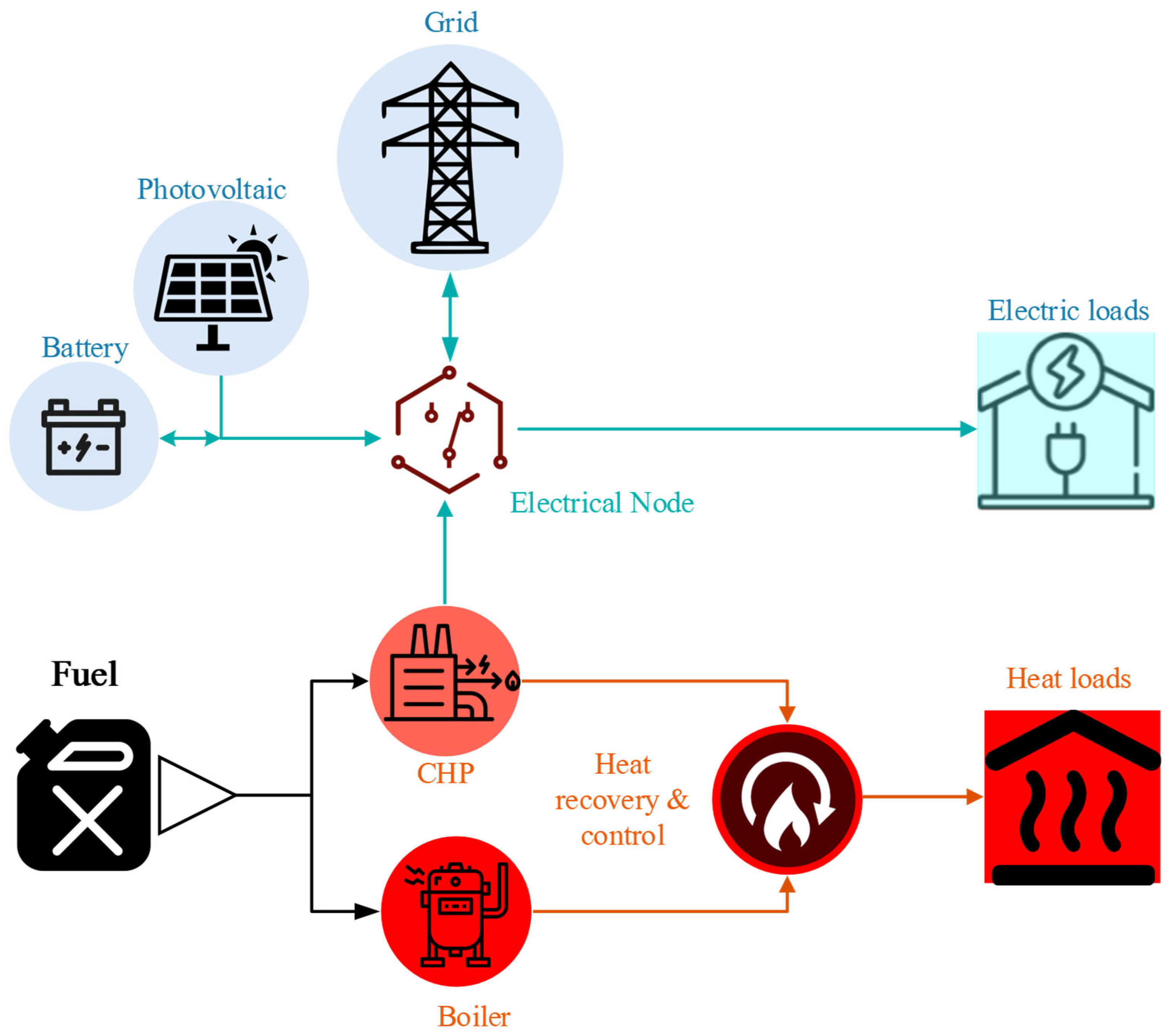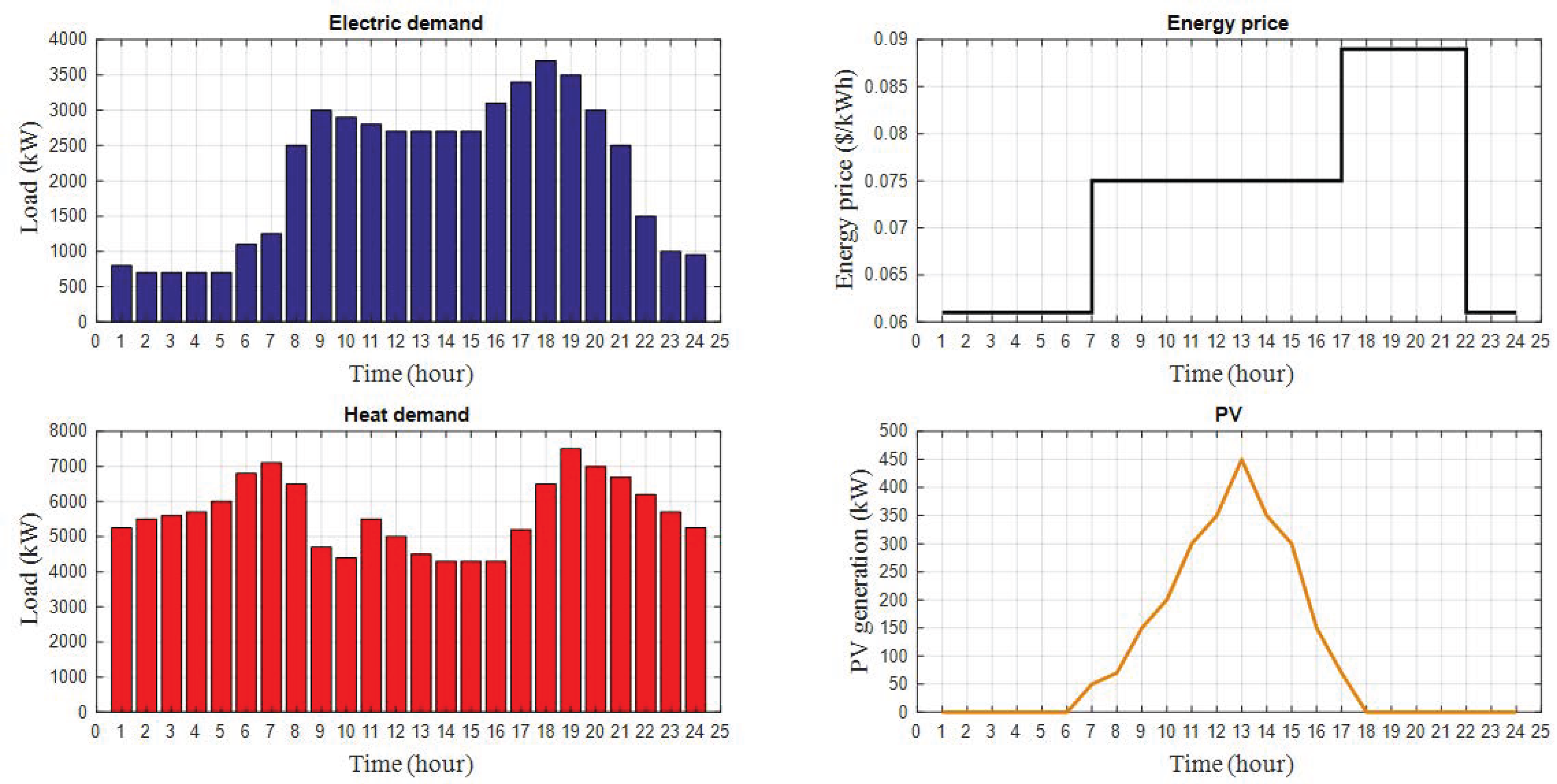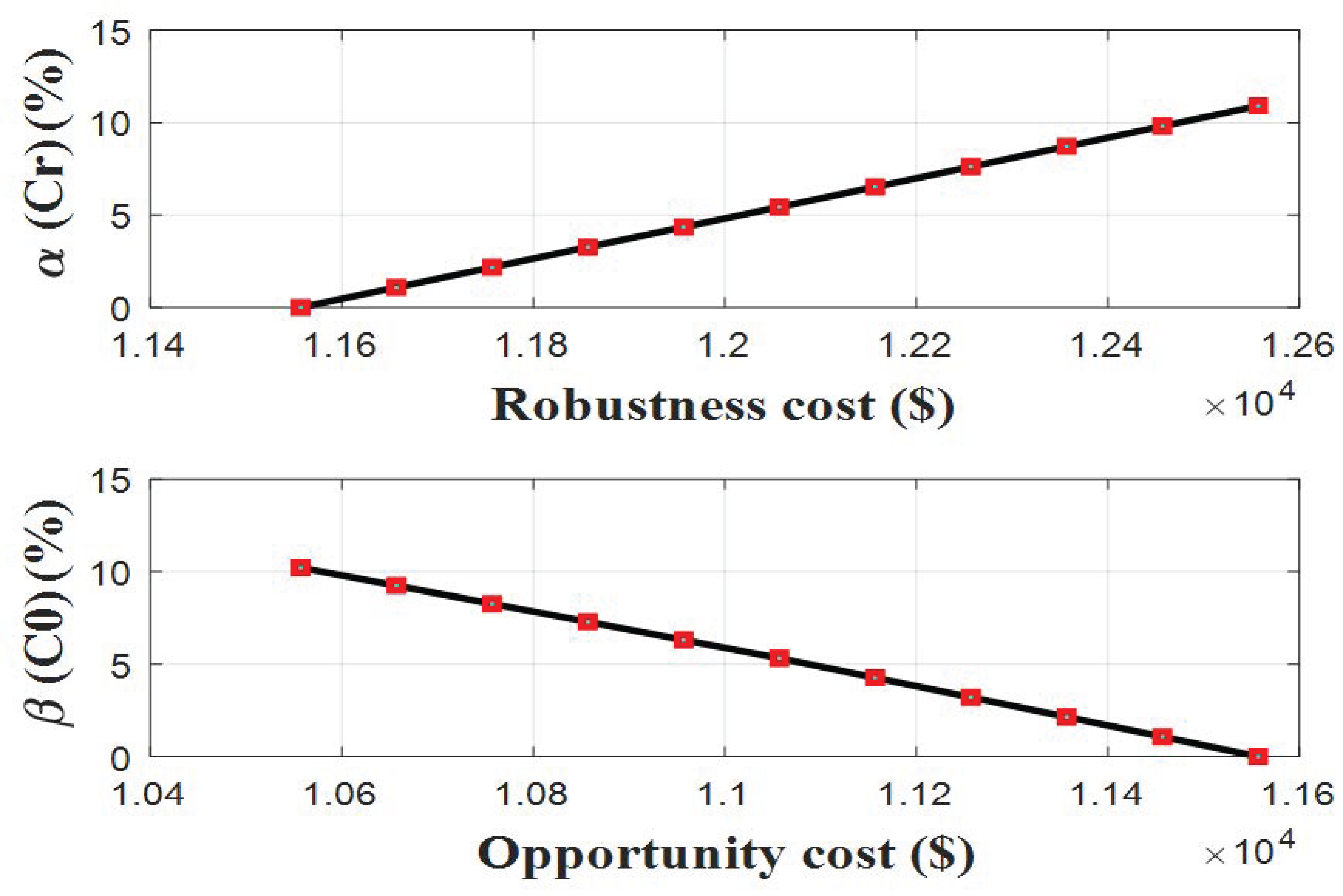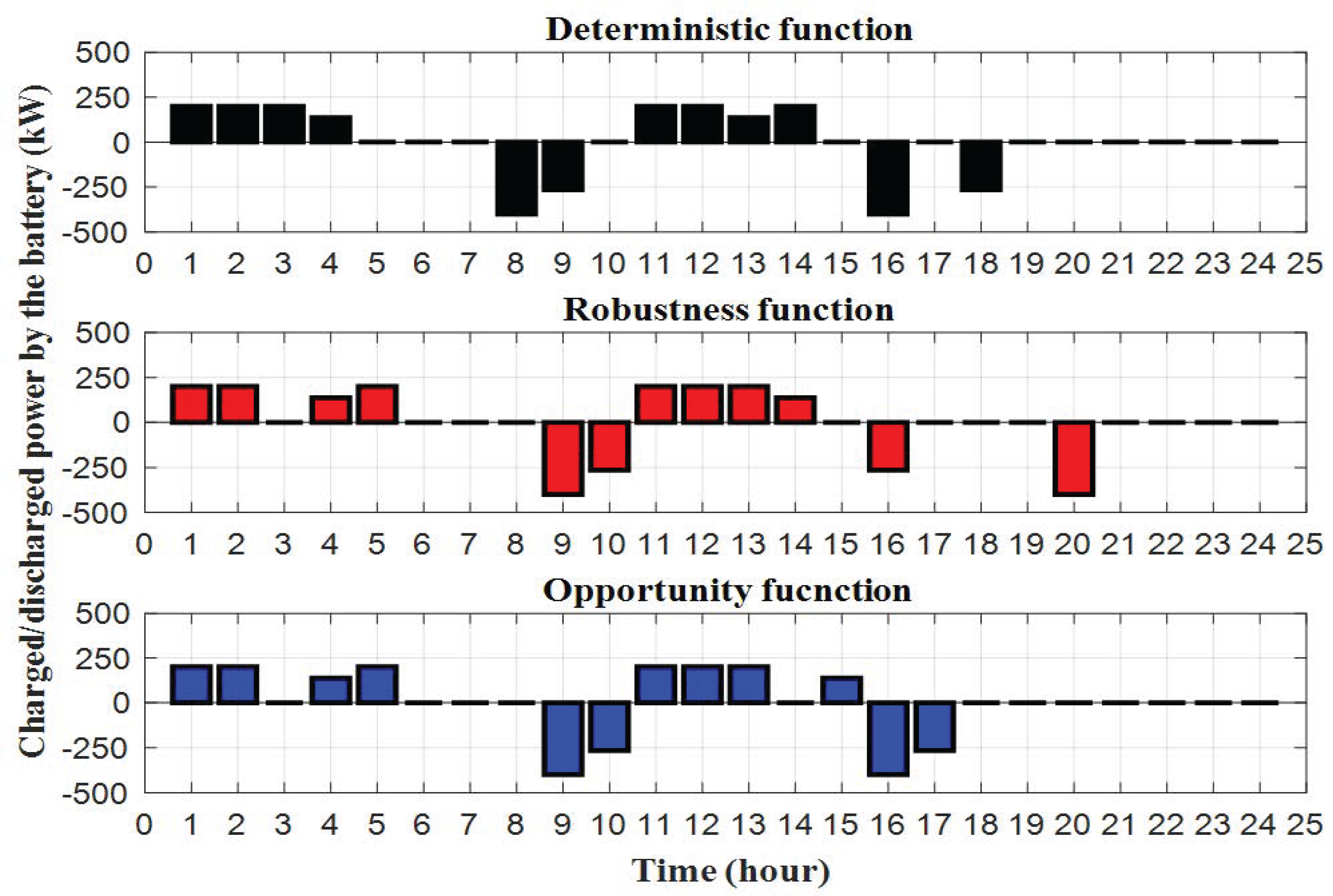Information Gap Decision Theory-Based Risk-Averse Scheduling of a Combined Heat and Power Hybrid Energy System
Abstract
1. Introduction
Literature Review
- I.
- How we can expand the IGDT method to account for multiple uncertainties with conflicting effects in an integrated optimization model?
- II.
- In comparison with a risk-neutral strategy, what is the difference between robust and optimistic scheduling strategies?
- Providing a mixed-integer linear problem for scheduling a sustainable hybrid energy system considering the CHP unit;
- Proposing a comprehensive IGDT method for addressing various uncertainty parameters in an integrated form, without a need for a precise data set or known probability distribution function;
- Providing a more flexible decision-making framework that is in favor of both risk-averse and risk seeker decision makers despite the conservative decisions of the robust approach;
- Proposing envelope-bound IGDT with a tractable procedure and efficient solution time.
2. Background Regarding Uncertainty Modeling Using IGDT
3. Problem Statement
- a.
- Deterministic optimal scheduling of the HESThe deterministic optimization presented in this subsection corresponds to a risk-neutral decision-making problem. Similar to any optimization problem, the HES scheduling problem consists of an objective function stated in (3), subject to operational constraints in (4)–(18). Equation (3) defines the objective function trying to minimize the total cost. Equation (4) calculates the cost of power exchange between the HES and grid based on energy prices. According to the amount of power generated by the CHP unit, the fuel cost is calculated as (5). Similarly, the fuel cost of the boiler system is calculated in (6). The amount of heat produced by the CHP and boiler units is delivered to the heat recovery system calculated in (7). The thermal energy balance is assured in (8) considering the efficiency of the heat recovery system. Constraints (9) and (10) limit the power output of the CHP and thermal energy of the boiler, respectively. Constraints (11)–(16) represent the model of the battery storage operation. Using (11) and (12), the stored electrical power in the battery storage is determined based on the initial state of charge and charged/discharged power. Equations (13) and (14) restrict the charged and discharged powers. The simultaneous charging and discharging are forbidden by (15). Finally, the capacity of the battery storage is limited by (16).The electrical and thermal energy balances are held by (17) and (18), respectively.
- b.
- IGDT-based optimal scheduling of the HESThe IGDT is applied to manage the uncertainties of energy price, PV generation, and electric and heat loads simultaneously. The fractional information gap model is presented in (19). If the uncertainty model was represented by , then would represent the uncertain parameters’ actual values (i.e., energy price, PV generation, electric load, and heat load demands), is the forecasted amounts of the mentioned uncertain parameters, and indicates horizon of the uncertainty parameter. A greater value of leads to a greater range of deviation of the uncertain parameters.Based on the definition, the IGDT-based optimal scheduling of the HES can be formulated as follows. For a risk-averse decision maker, the robustness function can be expressed as (20).where models the system cost, q includes decision variables, contains uncertain parameters, and is the maximum or critical operational cost of the HES, which the results should not exceed. In fact, the risk-averse decision maker tries to find the maximum bound of the uncertainty in a way the operation cost is not more than a predefined cost. is the base cost of the system according to forecasted amounts of uncertain parameters. The base cost is the optimal cost of the deterministic problem presented in (3)–(18). is the cost deviation factor, which can adjust the target for the robust problem. The optimization problem (21)–(27) schedules the system operation in a robust condition. From the constraints, it can be deduced that when the maximized degree of uncertainty, , is lesser than the maximum level of uncertainties, , the operational cost will be lower than the critical cost, . It should be noted that after several numerical evolutions under the deterministic case, it was found that the total cost is higher when the energy price is targeted to be maximized (i.e., robust cost); for this reason, the effect of price is negative as shown in (23). While the PV generation can reduce the operational cost, the risk-averse decision maker would like to consider the PV output lower than its forecasting amount using robust optimization, as shown in (24). For a robust operation, the decision maker would like to consider more load demands as modeled in (25) and (26) for electrical and heat loads, respectively. Other constraints are the same as the deterministic problem as mentioned in (27).Subject to:On the contrary, for a risk-seeking decision maker, the mathematical model for the opportunity function is expressed in (28).where is the minimum cost of the system, which the results should not exceed. Thus, was the largest amount of , and is the smallest amount of . and , respectively, find the system cost with a high degree of robustness and the smallest cost of the system by considering positive attributes. Obviously, is always greater than . Therefore, the opportunity function can be formulated as follows. Despite the RA decision maker, the RS decision maker tries to find the minimum deviation of the uncertainty parameters that push the system operation toward a positive situation. For example, the risk seeker strategy anticipates that uncertainty reduces the energy price, increases the PV generation, and decreases the load consumptions in (31)–(34), respectively.Subject to:
4. Numerical Evolutions
5. Conclusions
Author Contributions
Funding
Institutional Review Board Statement
Informed Consent Statement
Data Availability Statement
Conflicts of Interest
Nomenclature
| Set | Definition | Set | Definition |
| t | Time index | i | Uncertainty index |
| Parameters | Definition | Parameters | Definition |
| , | Min/Max capacity of the battery (kWh) | Electric energy price (USD/kWh) | |
| Heat power of heat exchanger (kW) | Fuel price (USD/kWh) | ||
| Heat capacity of boiler unit (kW) | Electric operation efficiency of CHP | ||
| Heat load (kW) | Efficiency of boiler | ||
| Electric load (kW) | Heat loss constant | ||
| Max. power capacity of CHP (kWh) | The efficiency of the heat recovery system | ||
| , | Min/Max charge power of the battery (kW) | The efficiency of the heat exchanger system | |
| , | Min/Max discharge power of the battery (kW) | , | Efficiency of battery |
| Variables | Definition | Variables | Definition |
| Cost of exchanged energy (USD) | Power sold to the grid (kW) | ||
| Cost of CHP power generation (USD) | Electric power by CHP unit (kW) | ||
| Cost of boiler heat generation (USD) | Electric power by PV system (kW) | ||
| State of energy of battery (kWh) | Charging power of the battery (kW) | ||
| The heat produced by the boiler (kW) | Discharging power of the battery (kW) | ||
| The heat produced by CHP (kW) | The binary variable of the charging state | ||
| Power bought from the grid (kW) | The binary variable of discharging state | ||
| Abbreviation | Definition | Abbreviation | Definition |
| CHP | Combined heat and power | MG | Microgrid |
| GAMS | General algebraic modelling system | PV | photovoltaic |
| HES | Hybrid energy system | RA | Risk-averse |
| IGDT | Information gap decision theory | RS | Risk seeker |
References
- Ramli, M.A.; Bouchekara, H.; Alghamdi, A.S. Efficient energy management in a microgrid with intermittent renewable energy and storage sources. Sustainability 2019, 11, 3839. [Google Scholar] [CrossRef]
- Dong, J.; Nie, S.; Huang, H.; Yang, P.; Fu, A.; Lin, J. Research on economic operation strategy of CHP microgrid considering renewable energy sources and integrated energy demand response. Sustainability 2019, 11, 4825. [Google Scholar] [CrossRef]
- Trairat, P.; Banjerdpongchai, D. Multi-Objective Optimal Operation of Building Energy Management Systems with Thermal and Battery Energy Storage in the Presence of Load Uncertainty. Sustainability 2022, 14, 12717. [Google Scholar] [CrossRef]
- Zhang, Y.; Meng, F.; Wang, R.; Kazemtabrizi, B.; Shi, J. Uncertainty-resistant stochastic MPC approach for optimal operation of CHP microgrid. Energy 2019, 179, 1265–1278. [Google Scholar] [CrossRef]
- Zeng, L.; Xu, J.; Wu, M.; Tang, J.; Wu, Q.; Wang, Q.; Fan, G. Day-ahead interval optimization for CCHP system considering uncertainty of wind power and PV. Int. J. Electr. Power Energy Syst. 2022, 138, 107895. [Google Scholar] [CrossRef]
- Nojavan, S.; Akbari-Dibavar, A.; Farahmand-Zahed, A.; Zare, K. Risk-constrained scheduling of a CHP-based microgrid including hydrogen energy storage using robust optimization approach. Int. J. Hydrog. Energy 2020, 45, 32269–32284. [Google Scholar] [CrossRef]
- Akbari-Dibavar, A.; Daneshvar, M.; Mohammadi-Ivatloo, B.; Zare, K.; Anvari-Moghaddam, A. Optimal Robust Energy Management of Microgrid with Fuel Cells, Hydrogen Energy Storage Units and Responsive Loads. In Proceedings of the 2020 International Conference on Smart Energy Systems and Technologies (SEST), Istanbul, Turkey, 7–9 September 2020; pp. 1–6. [Google Scholar] [CrossRef]
- Pashaei-Didani, H.; Mohammadi, A.; Ahmadi-Nezamabad, H.; Nojavan, S. Chapter 5—Information Gap Decision Theory. In Based Risk-Constrained Energy Management of DC Microgrids; Nojavan, S., Shafieezadeh, M., Ghadimi, N.B.T.-R.E.M., Eds.; Academic Press: Cambridge, MA, USA, 2020; pp. 67–82. [Google Scholar]
- Movahedpour, M.; Kiani, M.J.; Zadehbagheri, M.; Mohammadi, S. Microgrids Operation by Considering Demand Response and Supply Programs in the Presence of IGDT-Based Reverse Risk. IEEE Access 2022, 10, 48681–48700. [Google Scholar] [CrossRef]
- Jing, Z.; Luo, Z. An IGDT model for capacity configuration optimization of island microgrid. Energy Procedia 2019, 158, 2774–2779. [Google Scholar] [CrossRef]
- Nojavan, S.; Majidi, M.; Zare, K. Risk-based optimal performance of a PV/fuel cell/battery/grid hybrid energy system using information gap decision theory in the presence of demand response program. Int. J. Hydrog. Energy 2017, 42, 11857–11867. [Google Scholar] [CrossRef]
- Nojavan, S.; Saberi, K.; Zare, K. Risk-based performance of combined cooling, heating and power (CCHP)integrated with renewable energies using information gap decision theory. Appl. Therm. Eng. 2019, 159, 113875. [Google Scholar] [CrossRef]
- Liu, H.; Yousefi, N. Risk-limited scheduling of an SH’s consumption of energy based on IGDT in the presence of a solar thermal storage system. Int. J. Ambient. Energy 2020, 43, 3781–3795. [Google Scholar] [CrossRef]
- Nojavan, S.; Jermsittiparsert, K. Risk-Based Performance of Combined Heat and Power Based Microgrid Using Information Gap Decision Theory. IEEE Access 2020, 8, 93123. [Google Scholar] [CrossRef]
- Rabiee, A.; Abdali, A.; Mohseni-Bonab, S.; Hazrati, M. Risk-averse scheduling of combined heat and power-based microgrids in presence of uncertain distributed energy resources. Sustainability 2021, 13, 7119. [Google Scholar] [CrossRef]
- Hashemi, S.; Arasteh, H.; Shafiekhani, M.; Kia, M.; Guerrero, J. Multi-objective operation of microgrids based on electrical and thermal flexibility metrics using the NNC and IGDT methods. Int. J. Electr. Power Energy Syst. 2023, 144, 108617. [Google Scholar] [CrossRef]
- Mansour-Saatloo, A.; Ebadi, R.; Mirzaei, M.A.; Zare, K.; Mohammadi-Ivatloo, B.; Marzband, M.; Anvari-Moghaddam, A. Multi-objective IGDT-based scheduling of low-carbon multi-energy microgrids integrated with hydrogen refueling stations and electric vehicle parking lots. Sustain. Cities Soc. 2021, 74, 103197. [Google Scholar] [CrossRef]
- Sarlak, M.; Samimi, A.; Nikzad, M.; Salemi, A.H. IGDT-Based Robust Operation of Thermal and Electricity Energy-Based Microgrid with Distributed Sources, Storages, and Responsive Loads. Int. Trans. Electr. Energy Syst. 2022, 2022, 6002695. [Google Scholar] [CrossRef]
- Kia, M.; Shafiekhani, M.; Arasteh, H.; Hashemi, S.; Shafie-Khah, M.; Catalão, J. Short-term operation of microgrids with thermal and electrical loads under different uncertainties using information gap decision theory. Energy 2020, 208. [Google Scholar] [CrossRef]
- Nazari-Heris, F.; Mohammadi-Ivatloo, B.; Nazarpour, D. Network constrained economic dispatch of renewable energy and CHP based microgrids. Int. J. Electr. Power Energy Syst. 2019, 110, 144–160. [Google Scholar] [CrossRef]
- Tostado-Véliz, M.; Kamel, S.; Aymen, F.; Jordehi, A.R.; Jurado, F. A Stochastic-IGDT model for energy management in isolated microgrids considering failures and demand response. Appl. Energy 2022, 317, 119162. [Google Scholar] [CrossRef]
- Mirzaei, M.A.; Nazari-Heris, M.; Mohammadi-Ivatloo, B.; Zare, K.; Marzband, M.; Shafie-Khah, M.; Anvari-Moghaddam, A.; Catalão, J.P.S. Network-constrained joint energy and flexible ramping reserve market clearing of power- And heat-based energy systems: A two-stage hybrid igdt-stochastic framework. IEEE Syst. J. 2021, 15, 1547–1556. [Google Scholar] [CrossRef]
- Komeili, M.; Nazarian, P.; Safari, A.; Moradlou, M. Robust optimal scheduling of CHP-based microgrids in presence of wind and photovoltaic generation units: An IGDT approach. Sustain. Cities Soc. 2022, 78, 103566. [Google Scholar] [CrossRef]
- Najafi, A.; Pourakbari-Kasmaei, M.; Jasinski, M.; Lehtonen, M.; Leonowicz, Z. A medium-term hybrid IGDT-Robust optimization model for optimal self scheduling of multi-carrier energy systems. Energy 2022, 238, 121661. [Google Scholar] [CrossRef]
- Guo, Q.; Nojavan, S.; Lei, S.; Liang, X. Economic-environmental evaluation of industrial energy parks integrated with CCHP units under a hybrid IGDT-stochastic optimization approach. J. Clean. Prod. 2021, 317, 128364. [Google Scholar] [CrossRef]
- Benyaghoob-Sani, A.; Sedighizadeh, M.; Sedighizadeh, D.; Abbasi, R. A RA-IGDT model for stochastic optimal operation of a microgrid based on energy hub including cooling and thermal energy storages. Int. J. Electr. Power Energy Syst. 2021, 131, 107092. [Google Scholar] [CrossRef]
- Majidi, M.; Mohammadi-Ivatloo, B.; Soroudi, A. Application of information gap decision theory in practical energy problems: A comprehensive review. Appl. Energy 2019, 249, 157–165. [Google Scholar] [CrossRef]
- Romero-Quete, D.; Garcia, J.R. An affine arithmetic-model predictive control approach for optimal economic dispatch of combined heat and power microgrids. Appl. Energy 2019, 242, 1436–1447. [Google Scholar] [CrossRef]
- Sriyakul, T.; Jermsittiparsert, K. Economic scheduling of a smart microgrid utilizing the benefits of plug-in electric vehicles contracts with a comprehensive model of information-gap decision theory. J. Energy Storage 2020, 32, 102010. [Google Scholar] [CrossRef]
- Soroudi, A.; Ehsan, M. IGDT based robust decision making tool for DNOs in load procurement under severe uncertainty. IEEE Trans. Smart Grid 2013, 4, 886–895. [Google Scholar] [CrossRef]






| Ref. | Components Considered in MG | Uncertainties Modeled by IGDT | Decision-Making Strategy |
|---|---|---|---|
| [11] | PV/battery/fuel cell/grid | Electric load | RA/RS |
| [12] | CCHP/PV/wind/grid | Energy price | RA/RS |
| [13] | CHP/energy storage/grid | Energy price | RA/RS |
| [14] | CHP/grid | Electric and heat load | RA/RS |
| [15] | CHP/fuel-cell/PV/wind/battery/grid | Renewable generation | RA only |
| [16] | CHP/boiler/wind/energy storage | Electric load/renewable generation | RA/RS |
| [17] | CHHP/PV/wind/energy storage/P2X | Renewable power generation | RA only |
| [18] | CHP/boiler/grid/battery | Renewable power generation | RA only |
| [19] | CHP/boiler/wind/ energy storage/grid | Electric load/wind power generation | RA/RS |
| [20] | CHP/PV/wind/battery/grid | Electric load | RA/RS |
| [22] | CHP/wind/grid | Wind power generation | RA/RS |
| [23] | CHP/boiler/wind/PV/grid | Renewable generation | RA/RS |
| [24] | CHP/wind/energy storage/grid | Wind power generation | RA/RS |
| [25] | CCHP/wind/energy storage/grid | Wind power generation | RA only |
| [26] | CCHP/wind/PV/energy storage/gird | Electric and heat load/renewable generation/energy price | RA only |
| This paper | CHP/boiler/PV/battery/grid | Electric and heat load/PV generation/energy price | RA/RS |
Disclaimer/Publisher’s Note: The statements, opinions and data contained in all publications are solely those of the individual author(s) and contributor(s) and not of MDPI and/or the editor(s). MDPI and/or the editor(s) disclaim responsibility for any injury to people or property resulting from any ideas, methods, instructions or products referred to in the content. |
© 2023 by the authors. Licensee MDPI, Basel, Switzerland. This article is an open access article distributed under the terms and conditions of the Creative Commons Attribution (CC BY) license (https://creativecommons.org/licenses/by/4.0/).
Share and Cite
Shi, L.; Tian, M.-W.; Alizadeh, A.; Mohammadzadeh, A.; Nojavan, S. Information Gap Decision Theory-Based Risk-Averse Scheduling of a Combined Heat and Power Hybrid Energy System. Sustainability 2023, 15, 4825. https://doi.org/10.3390/su15064825
Shi L, Tian M-W, Alizadeh A, Mohammadzadeh A, Nojavan S. Information Gap Decision Theory-Based Risk-Averse Scheduling of a Combined Heat and Power Hybrid Energy System. Sustainability. 2023; 15(6):4825. https://doi.org/10.3390/su15064825
Chicago/Turabian StyleShi, Lumin, Man-Wen Tian, As’ad Alizadeh, Ardashir Mohammadzadeh, and Sayyad Nojavan. 2023. "Information Gap Decision Theory-Based Risk-Averse Scheduling of a Combined Heat and Power Hybrid Energy System" Sustainability 15, no. 6: 4825. https://doi.org/10.3390/su15064825
APA StyleShi, L., Tian, M.-W., Alizadeh, A., Mohammadzadeh, A., & Nojavan, S. (2023). Information Gap Decision Theory-Based Risk-Averse Scheduling of a Combined Heat and Power Hybrid Energy System. Sustainability, 15(6), 4825. https://doi.org/10.3390/su15064825







